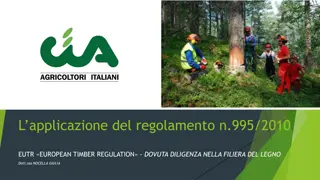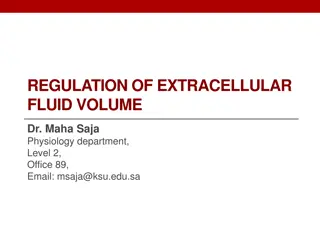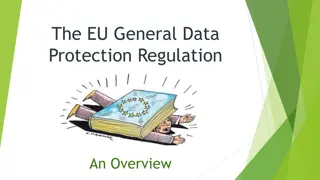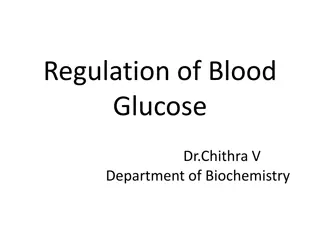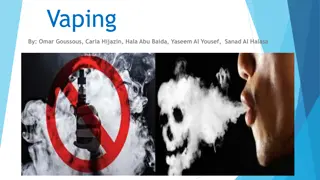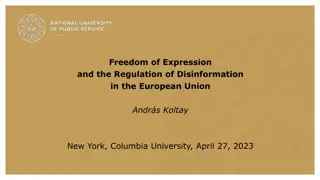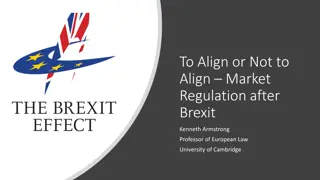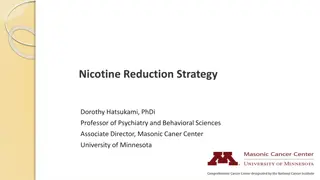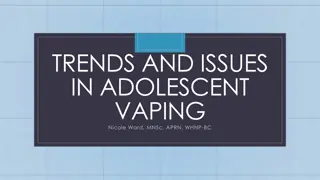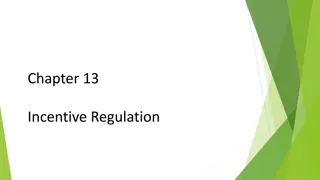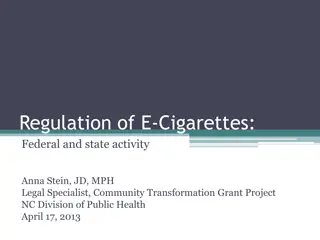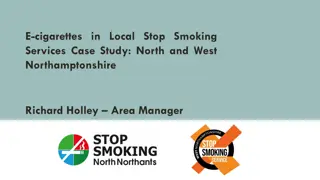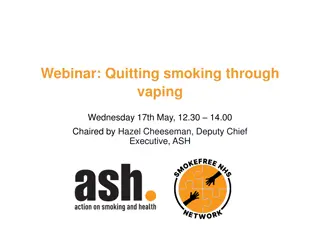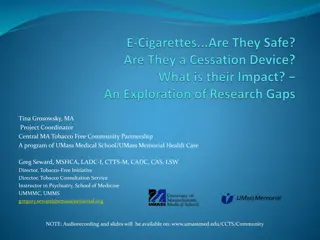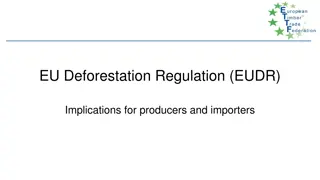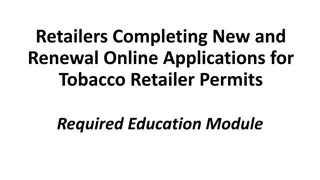Regulation of Flavors in E-cigarettes: Policy Implications and Findings
This presentation by Jody Sindelar at Yale School of Public Health discusses regulations on flavors in e-cigarettes, focusing on various studies exploring the impact of flavor regulation on vaping and smoking behaviors. The research, funded by NIH and other institutions, highlights key policy issues and presents findings from discrete choice experiments. The goal is to inform future policies at state and federal levels regarding flavor bans and Tobacco-21 laws.
Uploaded on Sep 28, 2024 | 2 Views
Download Presentation

Please find below an Image/Link to download the presentation.
The content on the website is provided AS IS for your information and personal use only. It may not be sold, licensed, or shared on other websites without obtaining consent from the author.If you encounter any issues during the download, it is possible that the publisher has removed the file from their server.
You are allowed to download the files provided on this website for personal or commercial use, subject to the condition that they are used lawfully. All files are the property of their respective owners.
The content on the website is provided AS IS for your information and personal use only. It may not be sold, licensed, or shared on other websites without obtaining consent from the author.
E N D
Presentation Transcript
Regulation of Flavors in E-cigarettes: Title of the Slide Methods, Findings, Meaning Jody Sindelar, Presenter Yale School of Public Health Coauthors on various papers in the series: J. Buckell, A. Friedman, K. Strombotne, J. Marti, J.C. Maclean Thank you to the organizers of TOPS, seminar series is a great idea.
Report on some in our series of publications on Title of the Slide regulations of smoking and vaping and related. Strombotne K, Buckell J, Sindelar JL. Who me? Optimism bias about US teenagers ability to quit vaping, submitted. Sindelar JL, Regulating Vaping: Policies, Possibilities and Perils. N Engl J Med. May 2020. Strombotne K, Buckell J, Sindelar JL Strombotne K, Buckell J, Sindelar JL. Do JUUL and e-cigarette flavors change risk perceptions of adolescents? Evidence from a national survey. Tobacco Control. 2020. Friedman AS, Buckell J, Sindelar JL. Tobacco-21 laws and young adult smoking: quasi-experimental evidence. Addiction. 2019 Oct;114(10):1816-1823. Buckell J, Sindelar JL. The impact of flavors, health risks, secondhand smoke and prices on young adults cigarette and e- cigarette choices: a discrete choice experiment. Addiction. 2019 Aug:114(8):1427-1435. Friedman AS, Buckell J, Sindelar JL. Patterns of Youth Cigarette Experimentation and Onset of Habitual Smoking. American Journal of Preventive Medicine. 2019 Jun;56(6):803-810. Buckell J, Hess S. Stubbing out hypothetical bias: improving tobacco market predictions by combining stated and revealed preference data. Journal of Health Economics. 2019 May;65:93-102. Marti J, Buckell J, Maclean JC, Sindelar JL. To vape or smoke? Experimental evidence on adult smokers. Economic Inquiry. 2019 Jan;57(1):705-725. Buckell J, Marti J, Sindelar JL. Should flavours be banned in cigarettes and e-cigarettes? Evidence on adult smokers and recent quitters from a discrete choice experiment. Tobacco Control. 2018 May 28.
Disclosures Title of the Slide Funding: NIH, Yale TCORS, NIDA, FDA Center for Tobacco Products (CTP) No funding from tobacco or related companies. Acknowledgement for many of our papers: Research reported in this publication was supported by grant numbers P50DA036151 and U54DA036151 from the National Institute on Drug Abuse (NIDA) and FDA Center for Tobacco Products (CTP). The content is solely the responsibility of the author(s) and does not necessarily represent the official views of the National Institutes of Health or the Food and Drug Administration.
Plan and Purpose of Presentation Title of the Slide Grand rounds style - use the accumulated knowledge across my/our studies for policy discussion; focus on one study in part to explain methods of DCE. Others show findings. Background key policy issues in regulation of flavors. Overview of 1 study mainly and another one- both Discrete Choice Experiments (DCE) on the impact of regulation of flavors on vaping and smoking. Next study. Consider impact of state flavor bans and Tobacco 21 policies at state level to understand future impact at federal level. Over-view of evidence needed for policy purposes. Meaning of results.
Background and Policy Issues: How to best regulate Title of the Slide flavors in e-cigarettes Key policy issues: Generally: How best to regulate all tobacco products- in advance of policy selection. Policy levers: flavors, nicotine levels, taxes/price, healthiness of ecigs; Tob 21. else Specifically: How to regulate flavors in e-cigarettes to prevent youths from vaping while allowing them to help smokers to quit. (max public health impact) E-cigarettes and JUUL. Key concern, rapid growth among youths, undermine LR decline in smoking rates. Examine flavor bans in context of other regulations, control for them & are of interest. We aim to provide needed information prior to decision-making by the FDA. Current research to examine state flavor bans to predict impact of FDA policies. Team: Jamie Tam, John Buckell, Rafael Meza, David Mendes, David Levy
Background Flavored JUULs and E-cigarettes Title of the Slide E-cigarettes came into the US market 2006/7. JUULs first sold in 2015; 75% market share at peak 2015 Claims to help smoker quit, but market to youths Attract young people; generally non-smoking youths Sleek, appealing, teen-appealing flavors. Restricted sales of some flavored pods to online only, 2018 Mango, fruit medley, cr me brulee, cucumber Available in stores- tobacco, menthol and mint All available online
Growth in vaping by high school students undermines the decline in smoking and use of other tobacco products CURRENT TOBACCO PRODUCT USE AMONG US HIGH SCHOOL STUDENTS, 2011 CURRENT TOBACCO PRODUCT USE AMONG US HIGH SCHOOL STUDENTS, 2011- - 2019. DATA ARE FROM THE NATIONAL YOUTH TOBACCO SURVEY AND WERE PROVIDED BY THE CENTERS NATIONAL YOUTH TOBACCO SURVEY AND WERE PROVIDED BY THE CENTERS FOR DISEASE CONTROL AND PREVENTION. (PAST 30 DAYS) PREVENTION. (PAST 30 DAYS) 2019. DATA ARE FROM THE FOR DISEASE CONTROL AND
Why Flavor Regulation as a Focus in Vaping? Title of the Slide Flavors in e-cigarettes Attract youths Misperceive the harm of ecigs suggests healthier than ccigs; Fruit flavors thought of as healthier (Strombotne, Buckell, Sindelar 2020). Menthol less harsh. Mint ditto. Appeal to youths. Can be regulated by FDA, states and localities. Specifically FDA has premarket enforcement power Could affect smokers quitting rate (but find not much for adults)
Percentage of flavor types used by current (past 30-day) flavored e-cigarette users among U.S. middle and high school students,* by device type , National Youth Tobacco Survey, United States, 2020 Title of the Slide . Wang et al. E-cigarette Use Among Middle and High School Students United States, 2020. MMWR Morb Mortal Wkly Rep. ePub: 9 September 2020. DOI: http://dx.doi.org/10.15585/mmwr.mm6937e1external icon.
Background: Regulation Federal and State. Title of the Slide (some regulations pre our articles, some post) FDA Congressional tobacco control act 2006-gave regulatory power to FDA. FDA deemed control of ecigs 2016. FDA has authority to enforce premarket control over flavored products. Some statements, enforcing staring Sept 13. What will it look like? When will be impact? Can factor flavors into assessment of impact on public health. States (and localities) Flavor regulations after Thanksgiving 2019. E-cigarettes mainly, but also menthol in cigarettes (MA, and soon CA) Localities- around the same time as states Federal government implemented Tobacco 21 law, effective January 2020
Aims of this work. Analyze impacts of alternative, future regulations & to provide findings in advance Title of the Slide of selection of policies. New alternative regulations such as bans on flavors in ecigs or cigs cannot be studied using real world data if not have been implemented (was true when started, now there are state regs). Want population-based impact but also by key groups, e.g. youths, African American smokers (re menthol in cigs). Need timely data as the tobacco landscape changes rapidly. Need to understand trade-offs and unintended impacts, e.g. substitute to unregulated products.
We Use a Discreet Choice Experiments (DCEs). Title of the Slide Why? Utility based choices, McFadden, 1974, indirect utility Provide findings in advance of policy selection Collect own, purposeful data Rigorous, well documented methods. E.g..Hauber, et al. 2016Johnson et al. 2013 Bridges et al. 2011, ISPOR Timely findings and designed for specific policy to examine Focus on & estimate trade-offs across policy options and cig types Use estimates to predict/simulate impact under alternative policies Examine heterogeneity in responses to regulation; define types e.g. dedicated smokers, vapers, dual who respond differently Important difference found
Methods: Discrete Choice Experiment Title of the Slide Examples of other tobacco DCEs DS Kenkel, et al. Health Economics. 2020 MF Pesko et al. Addiction 2016. C Shang et al. Tob Control. 2018 C Shang et al. Tob Regul Sci. 2020 Marti J, Buckell J, Maclean JC, Sindelar JL. Economic Inquiry. 2019
DCE 1: How will different flavor bans impact public Title of the Slide health? Buckell, J., Marti, J., & Sindelar, J. L. Should Flavors Be Banned In E-Cigarettes? Evidence On Adult Smokers And Recent Quitters From A Discrete Choice Experiment. Tob. Control 2019, 28.168-175 What would be the best set of flavor bans on ccigs and ecigs? Ban menthol? All flavors? Maintain status quo? Ban similarly or optimally different across ccigs and ecigs? Heterogenous impact by demographics and types of smokers/vapers? What are goals? Reduce smoking, minimize use of cigs and ecigs by youth?
What we added to previous literature Title of the Slide Predict impacts of alternative flavor bans across ccigs and ecigs using DCE results. Relative value of each attribute and product is derived and used in predictions. Compared impacts across policy options. (also see Marti et al, 2019). Focus on trade-offs across. Substitutes and complements. Examine ccigs and ecigs. Some studies examine only flavor bans on ccig and impact on ccigs, others examine flavors ban on both types
Sample Title of the Slide 2,031 current smokers and recent quitters (might vape, relapse). Large relative to other DCEs Had to have smoked at least 100 cigs in lifetime US residents ages 18-64 Quotas. matched BRFSS 2014 to get national representative sample. based on 6 regions, gender and age bans Online sample. Qualtrics platform.
DCE Methods and Steps- in general once have study Title of the Slide goals and sample Select attributes and determine levels . Confirm importance of each, policy-relevant Determine products to select among Assess if DCE too difficult, long, demanding, can understand Develop DCE and survey to accompany DCE. Select the most impactful set of choices. Randomize to groups to reduce response burden. Increase quality of data e.g. visuals to help explain products, practice questions, not too long nor too complicated, nor to many choice set Pilot- and use data to design subset of choice set Field study- choices are the data to analyze Analyze data
Discrete Choice Experiment in our study Title of the Slide Products: combustibles, e-cigarettes, none of these (opt out) Attributes and levels Flavors: tobacco, menthol, fruit, sweet Nicotine level: high, low, medium (not think respondents would relate to quantitative levels) Health: die early by years Price
Experimental Design Title of the Slide Products: combustible cigarettes, e-cigarettes, opt out Attributes: flavors, health, nicotine level, price Levels: E.g. Flavors tobacco, menthol, fruit, sweet Nicotine- used qualitative
Choice Tasks: best-best (top 2 choices) Online. Title of the Slide Best-best DCE 2 choices per scenario 2 opt outs 12 scenarios per individual-Can t ask all possibilities. 3 sets to randomize Observations = 24,372(2 choices for each of 2031 respondents, 12 choices) Choices are the data to analyze.
Pilot first Title of the Slide Why? 1. Examine if respondents seem able to answer well, adjust if not 2. Ask follow-up questions, e.g. what was difficult to answer 3. Determine average response time; delete respondents who rush through 4. Use pilot data to optimize choice sets. 36 choice sets was optimal we randomized 3 groups to mutually exclusive set of 12 each (Too many in full set of choice options (4 attributes raised to the power of 4 levels: 4*4*4*4=256 possible choice sets!))
Accompanying Survey Alongside DCE Title of the Slide Why gather data in survey? Use responses as control variables. Use to form latent heterogenous groups. Policy relevant Ask about: Socio-econ and demographics Smoking and vaping history and current habit State and city of residence Knowledge, beliefs, perceptions re vaping Specifics developed for each study Else..
Promoting Data Quality Title of the Slide Promoting Data Quality: Strategies employed in order to ensure high-quality responses. Exclude respondents who rush through the survey Employ attention checks to ensure all respondents are active respondents (not straight-lining). Use progress bar to prevent dropouts Check for likely duplicates Qualtrics checks for same IP address and same socio-econ Use honesty pledges to increase the likelihood that respondents will complete the survey with fidelity.
Method of Analysis of Choice Data in this study Title of the Slide Exploded multinomial logit choice model (handles two choices) Combined fruit and sweet flavors into one variable (policy) Flavored cigarette type constant terms (combined flavors/products in models)-gives more direct preference measure Use rich set of sociodemographic/smoking. interactions
Methods: Choice Model and Utility Function Title of the Slide We build a utility function: (i=individual; j=product in c=choice set) This yields choice probabilities higher utility, more likely choice(omitted tobacco-ccig) Product-flavor constants (interact product constant with flavor preference e.g. menthol-ccig)
Results: Cigarette choice model Cigarette choice Results: Cigarette choice model Cigarette choice Title of the Slide model without interaction model without interaction Parameters Constant: menthol combustible cigarette Coef. (s.e.) 0.38 (0.035) Sig. *** Results; Coefficients on constant terms are measures of the preferences. Sample prefers the omitted category of: tobacco cigs. (negative coefficients on else) (sample current and recent smokers) Constant: tobacco e-cigarette *** 0.55 (0.037) Constant: menthol e-cigarette *** 0.88 (0.058) Constant: fruit/sweet e-cigarette *** 0.71 (0.040) Constant: none of these *** 1.87 (0.049) Price *** 0.08 (0.002) Nicotine: none *** 0.15 (0.024) Prefer Lower price Medium level of nicotine Healthier product Nicotine: low * 0.04 (0.019) Nicotine: high *** 0.06 (0.015) Health: unknown 0.30 (0.033) *** Health: 2 life years lost 0.37 (0.036) *** Health: 5 life years lost 0.18 (0.027) ***
Examine Heterogeneity Title of the Slide Interact flavor-product-constant with sociodemographic variables to examine heterogeneity Use these results to predict impacts
Results: Model Estimates, Exploded logit Title of the Slide Preferences vary substantially Find: older adults not like flavors, younger do Similar (where comparable) to other findings. Suggest validity
Simulations Generating Preferences For Modeling Title of the Slide Predict percentage of the population that selects each product type or none. These choice probabilities sum to 1 in each scenario. These choice probabilities are choice shares and are used to make predictions under alternative regulatory bans Compare the status quo (current regulations) to alternative regulations.
Potential flavor bans policy options; predict impact Title of the Slide Policy Permitted flavors by cigarette type. Combustible cigarettes MentholFruit/sweet E-cigarettes MentholFruit/sweet Current US Policy: ban fruit/sweet in ccig Allowed Banned Allowed Allowed Alternative 1: ban all flavors Alternative 2: only allow menthol ecig Ban Ban Ban Ban Ban Allow Ban Ban Alternative 3: ban all ccig flavors Ban Ban Allow Allow Alternative 4: only allow fruit/sweet ecig Ban Ban Ban Allow Alternative 5: ban all ecig flavors Allow Ban Ban Ban
Results: Model Predictions (subset) Title of the Slide Goals? Reduce smoking, use of any tobacco? % change predicted market share compared to current Ccig Ecig none Ban e-cigarette flavors 8.3 -11.1 3 Ban menthol in combustible cigarettes -5.2 3.8 1.6 Ban all non-tobacco flavors 2.7 -7.9 5.2
Summary of Findings Title of the Slide Predict: Banning flavors in e-cigarettes encourages smoking Banning menthol in combustibles minimizes smoking Banning all flavors in both types maximizes using neither- desirable, but smoking increases and is most harmful Find: Smokers and recent quitters prefer cigs and menthol cigs over ecigs with flavors Older adults prefer tobacco only Younger adults prefer flavors in cigs and ecigs (including tobacco)
Strengths, Cautions and Limitations Title of the Slide Strengths Large national sample Designed specifically to address questions Results before policy designed; cannot study policy not in place Steps to promote quality of DCE and data Heterogeneity identified- important Cautions and limitations Stated preferences but that is all that we have prior to policy (see Buckell, Hess, 2019) Fast changing markets esp. Tobacco 21 and youth demand Look only at produce choice not use in DCE but can ask about change in quantity and frequency expected in survey Can t include all attributes, levels and products (substitute to other products)
DCE Paper 2: Flavors and Young Adults Title of the Slide Buckell J, Marti J, Sindelar JL. Should flavours be banned in cigarettes and e-cigarettes? Evidence on adult smokers and recent quitters from a discrete choice. Addiction, 2019 Topic: Focus on youths as more interested in flavors, greater policy concern due to more vaping by youths Sample: 2003 obs., ages 18-22, national sample with quotas Methods: DCE with survey Attributes: Flavors, trouble breathing (short-term health), harm from second-hand smoke , price Products: Disposable ecig, reusable ecig, cigarette Choice data from 8 scenarios
DCE Paper 2: Flavors and Young Adults Title of the Slide Methods: MNL, latent class MNL Findings: Overall preferred: healthier products; fruit and candy flavor; Latent classes: found 2 groups with different preferences. Preferred vaping group liked fruit and candy most. Preferred healthier products even when price was high Preferred reusable. Preferred smoking group older, white, non-Hispanic, lower SES, less likely to be a student
DCE Paper 2: Flavors and Young Adults Title of the Slide Policy Implications Preferred smoking group: to get them to quit smoking, or not start, increase cig prices and reduce harms of ecig (FDA could regulate) But reducing the harms of ecigs would encourage Preferred- vaping group to vape more likely Conundrum for policy-making. Reduce health harms of ecigs results in more vaping but less smoking by youths. May want neither for youths.
Quasi-experimental Study- Survey based Title of the Slide Friedman AS, Buckell J, Sindelar JL.Tobacco-21 laws and young adult smoking: quasi-experimental evidence. Addiction. 2019 Oct;114(10):1816-1823. Take advantage of the exogenous (to youths) passage of the Tobacco 21 law making it illegal to sale tobacco products to youths. Compare the impact of the Tob21 on those above and below 21. In states with and without Tob 21 laws. Conduct a survey young adults on their smoking a vaping. Key finding. Tob 21 appears to reduce smoking among 18-20 year-olds relative to those 21-22 by a considerable amount among those who had ever tried cigarettes.
New. Examining impact of State Flavor Regulations Title of the Slide adjusting for Tobacco 21 laws in some states (fed Tob21 after states) Aim. to understand how state flavor bans, along with state Tob 21 laws (before and after the federal Tob21 law) affect smoking and vaping. Approach. Compare vaping and smoking across respondents in states groups with different sets of policies: 1. Ban flavors in both ecigs and menthol in cigs & Tob21- MA and CA ( soon?) 2. Flavor Ban & Tob21, states enacted permanent restrictions on flavored e-cigarettes. & Tob21. 3. Tob21 but no flavor bans 4. Neither Team. Key members: Rafael Meza, Jamie Tam, John Buckell, David Mendez, David Levy, Kurt Petschke
Examine State Flavor Regulations and Tob 21: Methods cont. Title of the Slide Surveys of 2000 obs of those ages 18-35- one of vapers and of smokers. Use quotas for representativeness. Measures ask pre post smoking and vaping. Self-report with memory prompts. CA could be almost in real time (maybe) Limitations-self reported data, recall issues, state differences (will control for) Strength- learn from differences by states; apply to FDA policy choices - in terms of policy, can factor state response in expected FDA impacts END OF DISCUSSION OF SPECIFIC STUDIES NOW MORE GENERAL REFLECTIONS
Overall reflections. Changing smoking and vaping landscape means need latest results Title of the Slide and policy predictions under current, or future, situation. Changes stemming from commercial firms. JUUL withdrew flavors from in-store sales. New disposable products with flavors entering market as FDA regulates pod type flavored ecigs Other new reduced harm products entering if mint is banned in ecigs, change marketing of menthol to appeal? States are passing laws, constantly in flux as contested in court, win/lose, try FDA- Sept 13 deadline for premarket enforcement , but impact unknown
Complications in assessing impacts of flavor and Title of the Slide other policies. Cont. Impact of future FDA regulations aimed at youth vaping may have lower than expected impacts due to Tob 21, state flavor bans. Commercial response. If mint is banned in ecigs, will companies adjust to overcome ban? E.g. change marketing of menthol to appeal similar to mint? Need to consider the breadth of products that are complements or substitutes: may become available in kid appealing flavors. Importance of heterogeneity in response to policy. (direct of latent classes) smokers v vapers socio-econ-demographics: age, race (blacks menthol) Youths and other groups may be priorities. Has COVID pandemic changed vaping /smoking tastes and preferences? Will there be a long-term impacts?
Meaning of results and policy implications: need to Title of the Slide translate results into policy implications (reminder) How to translate findings into policy implications? Want evidence-based policies, but there can be a need to translate results into policies. Consider, but not always have data on: unintended side effects, e.g. substitutability across unregulated products Changing landscape impact on different groups, e.g. youth (goal to prevent nicotine addiction) given heterogenous impacts and different goals. African Americans re menthol, those who want to quit smoking. Balance gains and losses when tradeoffs. Who to prioritize?
Thank you for your attention Title of the Slide . Questions, comments, ideas?


